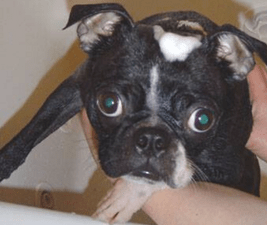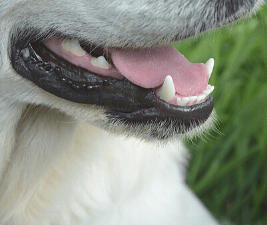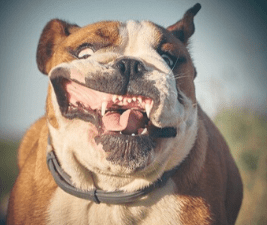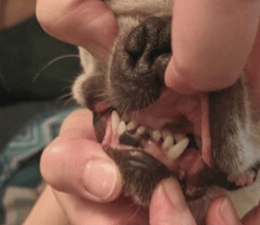Dog owners willingly shoulder the responsibility of caring for their canines. We all provide food, shelter, walks, training, etc. But the dog home grooming routine varies widely. And should, because the grooming needs of dogs depends on the breed of dog, type of coat, and individual needs of the animal.
Regular bathing
Most dogs, depending on their activity level and how much dirt they roll in, only need occasional baths. The timing varies from a couple of weeks for oily-coated dogs, to a couple of months for short-coated dogs.
The exception to the rule is dogs with skin conditions. We’ve dealt with various ones over the years. The most severe was Ceilidh, our tiny, ill-bred Boston Terrier girl whose system seemed to attack her skin and fur. Ceilidh got medicated baths every week, which kept her skin clear and her fur, minimal though it was, at its best.
The positives about having to give a dog a weekly bath are that you become expert at it (Fran is the dog bathing guru of the family), and the dog is so accustomed to it that it’s not a big deal. Since the medicated shampoo had to stay on for a while, we learned that it’s smart to reserve a favorite toy for bath time. If your dog only sees this special toy for her bath, it’s a treat, not a trauma.
Doggy facial
All of our dogs through the decades have been flat-faced breeds. Along with that comes a special obligation to keep face-folds clean and dry. We’re not sure if all breeds of dogs require regular face-washing, but it comes with the territory around here.
Only one of our dogs ever figured out how to use a “napkin” after eating. We used to hand a dish towel over the oven handle and this guy would go over and wipe his face after every meal. We wish all of them would, but we do it manually now. Our guys are messy eaters. And at least two of them munch on mud outside, so faces get wiped, if not washed, regularly.
Tooth brushing
Along with having flat-faced dogs comes fear of anesthesia. While all of our dogs are good breathers and have no particular issues, having to get them “put under” to get their teeth cleaned is scary.
Veterinary recommendations suggest dogs’ teeth should be brushed as often as people’s. But not even we can keep up a 2X/day schedule. Our dogs get chew toys every day. Regular tooth brushing, with our own formula toothpaste, is once per week. It seems to be working. All of our dogs, from the 3-year-old to the 12-year-old, get good reports at the vet, without ever having a professional cleaning.
Brushing
Long-coated dogs need daily brushing. And our groomer friends tell us that the biggest problem they see is incomplete brushing. Apparently you have to get all the way down to the dog’s skin to do a good job. If you’re not sure what kind of brush to use for your dog’s particular fur, ask your groomer. They should be happy to recommend the tools that will make their job easier!
For our short-coated dogs (Boston Terriers, French Bulldogs) we use a rubber curry brush, three times a week. And it’s always a surprise to see who’s shedding and how much. You would think that shedding would be seasonal, but it varies widely. One day we get enough fur to joke about making a puppy. The next time there’s barely anything.
Nails
Most of the advice we see from professional dog people says dogs need their nails trimmed about every four to six weeks. We wish that were true for our bunch. They seem to grow like weeds, and we wind up doing nail-grinding almost every week. Our criteria is that dog nails shouldn’t curl, and you shouldn’t be able to hear them on hard floors. We know that’s a bit extreme for most people, but it works for us and our dogs.
Golly (Brussels Griffon) got a toenail torn off twice in her life. On a scale of dog emergencies, it’s a minor one. But it was also messy, painful for Golly, and took quite a while to heal.
Dog home grooming
Sunday morning is our regular time for dog home grooming – nails, teeth, face, ears, bathing if needed. Make it a habit to give your dog a once-over, at least once a week.












